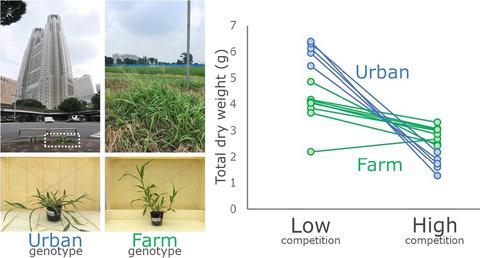Our official English website, www.x-mol.net, welcomes your feedback! (Note: you will need to create a separate account there.)
Contemporary adaptive divergence of plant competitive traits in urban and rural populations and its implication for weed management
Journal of Ecology ( IF 5.5 ) Pub Date : 2020-07-08 , DOI: 10.1111/1365-2745.13472 Yuya Fukano 1 , Wei Guo 1 , Kei Uchida 1 , Yuuya Tachiki 2
中文翻译:

城乡人口植物竞争性特征的当代适应性差异及其对杂草治理的启示
更新日期:2020-07-08
Journal of Ecology ( IF 5.5 ) Pub Date : 2020-07-08 , DOI: 10.1111/1365-2745.13472 Yuya Fukano 1 , Wei Guo 1 , Kei Uchida 1 , Yuuya Tachiki 2
Affiliation

|
- Competition among neighbouring plants plays essential roles in growth, reproduction, population dynamics, and community assembly, but how competition drives local adaptation and the traits underlying the adaptation remain unclear. Here, we focused on populations of the aggressive weed Digitaria ciliaris from urban and rural habitats as low‐ and high‐competition environments for light resources and examined how competitive interaction drove contemporary adaptive divergence of competitive traits.
- To examine local adaptation to different competitive environments in D. ciliaris and the specific traits that have been selected for, we compared growth rate and competitive traits in plants from farmland and urban populations between high‐ and low‐competition treatments. Furthermore, we conducted a field tillage experiment with drone (unmanned aerial vehicle) monitoring to examine the possibility that trait evolution in farmland habitats might influence weed management practices in crop fields.
- Plants from farmland populations had higher growth rates than plants from urban populations in high‐competition treatments, and vice versa in low‐competition treatments. Among populations, those with larger height/width ratios (farmland populations) were more tolerant of above‐ground competition in high‐competition treatments, but among individuals, those with larger ratios had lower growth rates in low‐competition treatments. More plants from farmland populations, which had thicker stems (and larger height/width ratios), survived after experimental tillage than plants from urban habitats with thinner stems.
- Synthesis. Our study empirically demonstrated adaptive divergence in competitive traits in above‐ground competitors and its underlying traits. Moreover, contemporary adaptive divergence between urban and rural plant populations has practical implications for weed control. The urban–rural model system can thus contribute to both basic and applied research in plant evolutionary ecology. Further research is required to understand adaptive divergence in plants between urban and rural environments, and the traits underlying the adaptation, not only above‐ground but also below‐ground.
中文翻译:

城乡人口植物竞争性特征的当代适应性差异及其对杂草治理的启示
- 相邻植物之间的竞争在生长,繁殖,种群动态和社区聚集中起着至关重要的作用,但是竞争如何驱动当地的适应以及适应的基本特征尚不清楚。在这里,我们集中研究了城市和农村生境中作为低和高竞争性轻型资源环境的侵略性杂草Digitaria ciliaris种群,并研究了竞争相互作用如何驱动当代适应性竞争特征的差异。
- 为了检验当地对纤毛虫不同竞争环境的适应性以及已选择的特定性状,我们比较了高竞争和低竞争处理之间农田和城市人口植物的生长速率和竞争性状。此外,我们进行了无人驾驶飞机监测的田间耕作试验,以检验农田栖息地的性状演变可能影响作物田杂草管理实践的可能性。
- 在高竞争性处理中,农田种群的植物的生长速率高于城市人口,而在低竞争性处理中则相反。在人群中,高/宽比大的人群(农田人口)在高竞争性治疗中更能忍受地上竞争,但在个体中,高/宽比大的人群在低竞争性治疗中低生长率。耕种后的耕地存活下来的农作物比茎秆较细的城市生境的植物多,而茎秆较粗(高宽比更大)。
- 综合。我们的研究从经验上证明了地上竞争者的竞争特征及其基本特征的适应性差异。而且,当代城乡植物种群之间的适应性差异对杂草控制具有实际意义。因此,城乡模型系统可以为植物进化生态学的基础研究和应用研究做出贡献。需要进一步的研究来理解城市和乡村环境之间植物的适应性差异,以及适应的基本特征,不仅是地上的,而且是地下的。



























 京公网安备 11010802027423号
京公网安备 11010802027423号